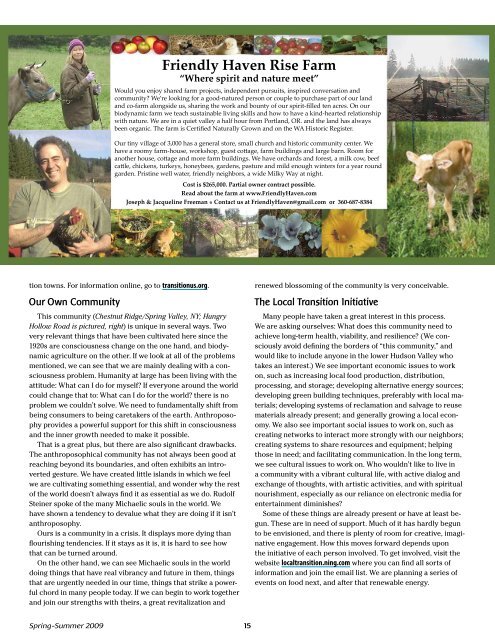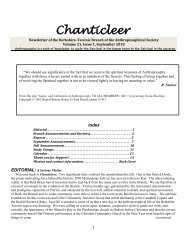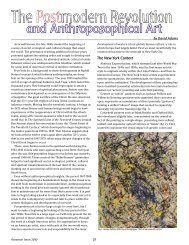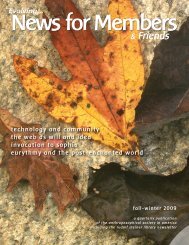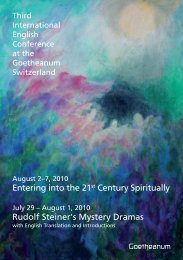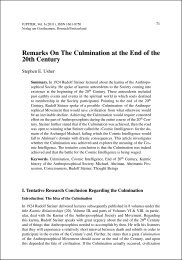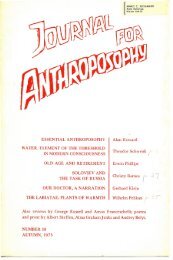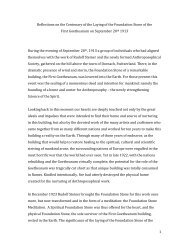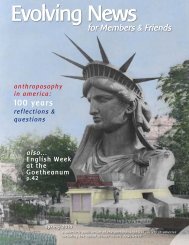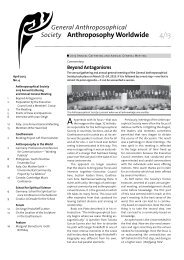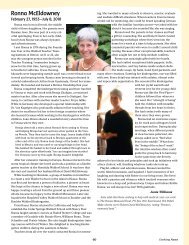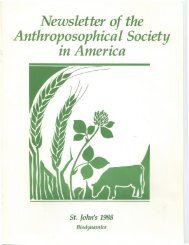Download - Anthroposophical Society in America
Download - Anthroposophical Society in America
Download - Anthroposophical Society in America
You also want an ePaper? Increase the reach of your titles
YUMPU automatically turns print PDFs into web optimized ePapers that Google loves.
Friendly Haven Rise Farm“Where spirit and nature meet”Would you enjoy shared farm projects, <strong>in</strong>dependent pursuits, <strong>in</strong>spired conversation andcommunity? We’re look<strong>in</strong>g for a good-natured person or couple to purchase part of our landand co-farm alongside us, shar<strong>in</strong>g the work and bounty of our spirit-filled ten acres. On ourbiodynamic farm we teach susta<strong>in</strong>able liv<strong>in</strong>g skills and how to have a k<strong>in</strong>d-hearted relationshipwith nature. We are <strong>in</strong> a quiet valley a half hour from Portland, OR. and the land has alwaysbeen organic. The farm is Certified Naturally Grown and on the WA Historic Register.Our t<strong>in</strong>y village of 3,000 has a general store, small church and historic community center. Wehave a roomy farm-house, workshop, guest cottage, farm build<strong>in</strong>gs and large barn. Room foranother house, cottage and more farm build<strong>in</strong>gs. We have orchards and forest, a milk cow, beefcattle, chickens, turkeys, honeybees, gardens, pasture and mild enough w<strong>in</strong>ters for a year roundgarden. Prist<strong>in</strong>e well water, friendly neighbors, a wide Milky Way at night.Cost is $265,000. Partial owner contract possible.Read about the farm at www.FriendlyHaven.comJoseph & Jacquel<strong>in</strong>e Freeman h Contact us at FriendlyHaven@gmail.com or 360-687-8384tion towns. For <strong>in</strong>formation onl<strong>in</strong>e, go to transitionus.org.Our Own CommunityThis community (Chestnut Ridge/Spr<strong>in</strong>g Valley, NY; HungryHollow Road is pictured, right) is unique <strong>in</strong> several ways. Twovery rele vant th<strong>in</strong>gs that have been cultivated here s<strong>in</strong>ce the1920s are consciousness change on the one hand, and biodynamicagriculture on the other. If we look at all of the problemsmentioned, we can see that we are ma<strong>in</strong>ly deal<strong>in</strong>g with a consciousnessproblem. Humanity at large has been liv<strong>in</strong>g with theattitude: What can I do for myself? If everyone around the worldcould change that to: What can I do for the world? there is noproblem we couldn’t solve. We need to fundamentally shift frombe<strong>in</strong>g con sumers to be<strong>in</strong>g caretakers of the earth. Anthroposophypro vides a powerful support for this shift <strong>in</strong> consciousnessand the <strong>in</strong>ner growth needed to make it possible.That is a great plus, but there are also significant drawbacks.The anthroposophical community has not always been good atreach<strong>in</strong>g beyond its boundaries, and often exhibits an <strong>in</strong>trovertedgesture. We have created little islands <strong>in</strong> which we feelwe are cultivat<strong>in</strong>g someth<strong>in</strong>g essen tial, and wonder why the restof the world doesn’t always f<strong>in</strong>d it as essential as we do. RudolfSte<strong>in</strong>er spoke of the many Michaelic souls <strong>in</strong> the world. Wehave shown a ten dency to devalue what they are do<strong>in</strong>g if it isn’tanthroposophy.Ours is a community <strong>in</strong> a crisis. It displays more dy<strong>in</strong>g thanflourish<strong>in</strong>g tendencies. If it stays as it is, it is hard to see howthat can be turned around.On the other hand, we can see Michaelic souls <strong>in</strong> the worlddo<strong>in</strong>g th<strong>in</strong>gs that have real vibrancy and future <strong>in</strong> them, th<strong>in</strong>gsthat are urgently needed <strong>in</strong> our time, th<strong>in</strong>gs that strike a powerfulchord <strong>in</strong> many people today. If we can beg<strong>in</strong> to work togetherand jo<strong>in</strong> our strengths with theirs, a great revitalization andrenewed blossom<strong>in</strong>g of the commu nity is very conceivable.The Local Transition InitiativeMany people have taken a great <strong>in</strong>terest <strong>in</strong> this process.We are ask<strong>in</strong>g ourselves: What does this community need toachieve long-term health, viability, and resilience? (We consciouslyavoid def<strong>in</strong><strong>in</strong>g the borders of “this commu nity,” andwould like to <strong>in</strong>clude anyone <strong>in</strong> the lower Hudson Valley whotakes an <strong>in</strong>terest.) We see important eco nomic issues to workon, such as <strong>in</strong>creas<strong>in</strong>g local food pro duction, distribution,process<strong>in</strong>g, and storage; develop<strong>in</strong>g alternative energy sources;develop<strong>in</strong>g green build<strong>in</strong>g tech niques, preferably with local materials;develop<strong>in</strong>g systems of reclamation and salvage to reusematerials already pres ent; and generally grow<strong>in</strong>g a local economy.We also see important social issues to work on, such ascreat<strong>in</strong>g networks to <strong>in</strong>teract more strongly with our neighbors;creat<strong>in</strong>g systems to share resources and equipment; help<strong>in</strong>gthose <strong>in</strong> need; and facilitat<strong>in</strong>g communication. In the long term,we see cultural issues to work on. Who wouldn’t like to live <strong>in</strong>a community with a vibrant cultural life, with active dialog andexchange of thoughts, with artistic activities, and with spiritualnourish ment, especially as our reliance on electronic media forenterta<strong>in</strong>ment dim<strong>in</strong>ishes?Some of these th<strong>in</strong>gs are already present or have at least begun.These are <strong>in</strong> need of support. Much of it has hardly begunto be envisioned, and there is plenty of room for creative, imag<strong>in</strong>ativeengagement. How this moves forward depends uponthe <strong>in</strong>itiative of each person <strong>in</strong>volved. To get <strong>in</strong>volved, visit thewebsite localtransition.n<strong>in</strong>g.com where you can f<strong>in</strong>d all sorts of<strong>in</strong>formation and jo<strong>in</strong> the email list. We are plann<strong>in</strong>g a series ofevents on food next, and after that renewable energy.Spr<strong>in</strong>g-Summer 200915


